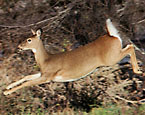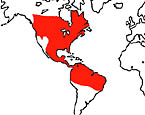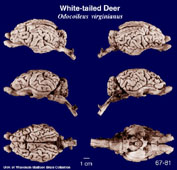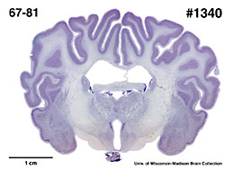|
White-tailed
Deer
(Odocoileus virginianus) #67-81 |
||||
|
|
Physical
characteristics and distribution
|
|
White-tailed Deer (Odocoileus virginianus) uses its tail as a 'white flag' to signal danger to others. The colors of their coats are gray-brown in the winter and reddish-brown in the summer. The underside of the tail is completely white. Their head and body lengths vary from 820-2,100 mm and weigh anywhere from 18-215 kg. Only the male White-tailed deer have antlers. They inhabit temperate to tropical deciduous forests. They are active both day and night feeding on grasses, weeds, twigs, shrubs, mushrooms, nuts, lichens and herbs. Vocalizations includes grunts and snorts. The basic social unit consists of small groups of individuals of the same sex. The most aggressive deer maintain dominance within their group. In some instances, males are left alone. In the mating season, the males rub their facial scent glands on vegetation, and urinate into scrapes beneath bushes and trees. This activity is used to demarcate their territories, communicate with females, and to intimidate other males. Females are seasonally polyestrous with an estrous cycle of about 28 days and an estrus of 24 hours. After 7 months of gestation, the female gives birth to 1 or 2 fawns that are able to walk a few hours after they are born. White-tailed Deer are located in S Canada extending N of 60ºN in the North West Territory and in the Yukon, USA (absent from California to W Colorado), and all nations of Central America; South America in Bolivia, N Brazil, Columbia, French Guiana, Guyana, Peru, Surinam and Venezuela. They have been introduced to the Czech Republic, Finland, New Zealand, and West Indies, possibly surviving on Cuba, Curacao, St. Croix, and St. Thomas Isls. |
|
Description
of the brain
|
|
Animal
source and preparation
|
|
All
specimens collected followed the same preparation
and histological procedure.
|
Other Related Resources (websites and publications)
List of Specimens | Explore Collections | Brain Sections | Brain Evolution | Brain Development | Brain Circuitry | Brain Functions | Location and Use | Related Web Sites | Contact Us | Search MSU Database | Personnel | Home



